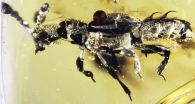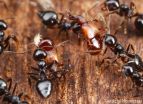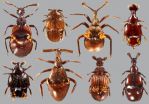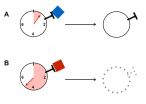(Press-News.org) Scientists have uncovered the fossil of a 52-million-year old beetle that likely was able to live alongside ants—preying on their eggs and usurping resources—within the comfort of their nest. The fossil, encased in a piece of amber from India, is the oldest-known example of this kind of social parasitism, known as "myrmecophily." Published today in the journal Current Biology, the research also shows that the diversification of these stealth beetles, which infiltrate ant nests around the world today, correlates with the ecological rise of modern ants.
"Although ants are an integral part of most terrestrial ecosystems today, at the time that this beetle was walking the Earth, ants were just beginning to take off, and these beetles were right there inside the ant colonies, deceiving them and exploiting them," said lead author Joseph Parker, a research associate at the American Museum of Natural History and postdoctoral researcher at Columbia University, who is a specialist on these beetles. "This tells us something not just about the beetles, but also about the ants—their nests were big enough and resource-rich enough to be worthy of exploitation by these super-specialized insects. And when ants exploded ecologically and began to dominate, these beetles exploded with them."
Today, there are about 370 described species belonging to Clavigeritae, a group of myrmecophilous, or "ant-loving" beetles about 1–3 millimeters in length, and Parker estimates that several times this number of species still await discovery. Remarkable adaptations enable these beetles to bypass the fortresslike security of ant nests, which employ a pheromone code of recognition that ants use to identify, and then dismember and consume, intruders. Through ways that scientists are still trying to understand, Clavigeritae beetles pass through these defenses and integrate seamlessly into colony life.
"Adopting this lifestyle brings lots of benefits. These beetles live in a climate-controlled nest that is well protected against predators, and they have access to a great deal of food, including the ants' eggs and brood, and, most remarkably, liquid food regurgitated directly to their mouths by the worker ants themselves," Parker said. "But pulling off this way of life means undergoing drastic morphological changes."
Clavigeritae beetles look quite different from their closest relatives, with fusions of segments within the abdomen and antennae—likely meant to provide additional protection from the ants, which often pick the beetles up and carry them around the nest—and mouthparts that are recessed inside the head in order to accept liquid food from worker ants. They also have glands that cover the body with oily secretions, and thick brushes of hair on top of their abdomens, called trichomes, which act as candlewicks and conduct chemical-containing secretions from nearby glands. The makeup of these chemicals is unknown, but they are thought to encourage ants to "adopt" rather than attack the beetles.
"If you watch one of these beetles interact inside an ant colony, you'll see the ants running up to it and licking those brush-like structures," Parker said.
Although Clavigeritae beetles are species-rich, they are quite rarely encountered in nature and so, unsurprisingly, the newly discovered specimen—brought to Parker's attention by American Museum of Natural History curator David Grimaldi, who is an expert in amber fossils—is thought to be the first fossil of this group to be discovered. Named Protoclaviger trichodens by Parker and Grimaldi, the Eocene fossil is from an amber deposit in what was once a rain-forest environment in modern-day India. Although its body is very similar to modern Clavigeritae beetles, with two stark, hook-like trichomes, some of its characteristics are clearly more primitive. For example, Protoclaviger's abdominal segments are still distinct, whereas in modern beetles they are fused together into a single shieldlike segment.
"Protoclaviger is a truly transitional fossil," Parker said. "It marks a big step along the pathway that led to the highly modified social parasites we see today, and it helps us figure out the sequence of events that led to this sophisticated morphology."
INFORMATION:
52-million-year-old amber preserves 'ant-loving' beetle
Eocene fossil is oldest-known social parasite of ants, correlates with the ecological rise of modern ants
2014-10-02
ELSE PRESS RELEASES FROM THIS DATE:
Counting the seconds for immunological tolerance
2014-10-02
Our immune system must distinguish between self and foreign and in order to fight infections without damaging the body's own cells at the same time. The immune system is loyal to cells in the body, but how this works is not fully understood. Researchers in the Departments of Biomedicine and Nephrology at the University Hospital and the University of Basel have discovered that the immune system uses a molecular biological clock to target intolerant T cells during their maturation process. These recent findings have been reported in the scientific journal Cell.
A functioning ...
DNA 'bias' may keep some diseases in circulation, Penn biologists show
2014-10-02
It's an early lesson in genetics: we get half our DNA from Mom, half from Dad.
But that straightforward explanation does not account for a process that sometimes occurs when cells divide. Called gene conversion, the copy of a gene from Mom can replace the one from Dad, or vice versa, making the two copies identical.
In a new study published in the American Journal of Human Genetics, University of Pennsylvania researchers Joseph Lachance and Sarah A. Tishkoff investigated this process in the context of the evolution of human populations. They found that a bias toward ...
Study indicates possible new way to treat endometrial, colon cancers
2014-10-02
Scientists love acronyms.
In the quest to solve cancer's mysteries, they come in handy when describing tongue-twisting processes and pathways that somehow allow tumors to form and thrive. Two examples are ERK (extracellular-signal-related kinase) and JNK (c-June N-Terminal Kinase), enzymes that may offer unexpected solutions for treating some endometrial and colon cancers.
A study led by Gordon Mills, M.D., Ph.D., professor and chair of Systems Biology at The University of Texas MD Anderson Cancer Center with Lydia Cheung, Ph.D. as the first author, points to cellular ...
Study gauges humor by age
2014-10-02
Television sitcoms in which characters make jokes at someone else's expense are no laughing matter for older adults, according to a University of Akron researcher.
Jennifer Tehan Stanley, an assistant professor of psychology, studied how young, middle-aged and older adults reacted to so-called "aggressive humor"—the kind that is a staple on shows like The Office.
By showing clips from The Office and other sitcoms (Golden Girls, Mr. Bean, Curb Your Enthusiasm) to adults of varying ages, she and colleagues at two other universities found that young and middle-aged adults ...
Strong working memory puts brakes on problematic drug use
2014-10-02
AUDIO:
Atika Khurana, assistant professor in the University of Oregon's Department of Counseling Psychology and Human Services, provides a short summary and the implications of a study that looked at the...
Click here for more information.
EUGENE, Ore. -- Oct. 2, 2014 -- Adolescents with strong working memory are better equipped to escape early drug experimentation without progressing into substance abuse issues, says a University of Oregon researcher.
Most important in the picture ...
Sense of invalidation uniquely risky for troubled teens
2014-10-02
PROVIDENCE, R.I. [Brown University] — Among the negative feelings that can plague a teen's psyche is a perception of "invalidation," or a lack of acceptance. A new study by Brown University and Butler Hospital researchers suggests that independent of other known risk factors, measuring teens' sense of invalidation by family members or peers can help predict whether they will try to harm themselves or even attempt suicide.
In some cases, as with peers, that sense of invalidation could come from being bullied, but it could also be more subtle. In the case of family, for ...
Socioeconomic factors, fashion trends linked to increase in melanoma
2014-10-02
NEW YORK, NY - A century's worth of cultural and historical forces have contributed to the rise in the incidence of melanoma, including changes in fashion and clothing design, according to an intriguing, retrospective research study conducted by investigators in the Ronald O. Perelman Department of Dermatology at NYU Langone Medical Center.
Their findings are the subject of a report, "More Skin, More Sun, More Tan, More Melanoma," in the October 6, 2014 issue of the American Journal of Public Health.
The authors surmised that early diagnosis and improved reporting ...
Herbivores play important role in protecting habitats from invasive species
2014-10-02
Champaign Ill. Herbivores (species that eat plants; e.g. caterpillars) consume more non-native (introduced from other places) oak leaf material in areas with diverse native plant communities than in less diverse communities. Why diverse plant communities tend to resist invasion by non-native plants, remains uncertain. Researchers from the Illinois Natural History Survey and the Morton Arboretum have been examining the potential role of herbivores on the invasion of non-native plant species in diverse plant communities.
The researchers examined herbivore damage on leaves ...
New report urges caution in handling eyewitness identifications
2014-10-02
WASHINGTON -- A new report from the National Research Council recommends best practices that law enforcement agencies and courts should follow to improve the likelihood that eyewitness identifications used in criminal cases will be accurate. Science has provided an increasingly clear picture of the inherent limits in human visual perception and memory that can lead to errors, as well as the ways unintentional cues during law enforcement processes can compromise eyewitness identifications, the report says.
"Human visual perception and memory are changeable, the ability ...
To life! Practicing Judaism could protect against suicide
2014-10-02
In 1897, Emile Durkheim, the father of sociology, speculated that religion could protect against against suicidal impulses. In the century that followed, numerous studies attempted to either prop up or debunk this theory, focusing primarily on Christianity, which condemns suicide as the worst of sins.
For the first time, a study published in European Psychiatry approaches Durkheim's premise through the lens of Judaism. According to the research, conducted by Dr. Gal Shoval and Dr. Ben Amit of Tel Aviv University's Sackler School of Medicine and Clalit Health Service's ...
LAST 30 PRESS RELEASES:
NCCN Summit seeks to improve care for veterans and first responders with cancer from line-of-duty exposure
ERC Consolidator Grant for soft robotics researcher
Dual-action arts and wellbeing program transforms dementia care
The global plastic waste trade contributes to coastal litter in importing countries, study shows
UT Dallas partners with Tech Mahindra on AI innovation
Blinking less could signal the brain is working harder to listen, Concordia study shows
Male bonobos track females’ reproductive cycle to maximize mating success
New report outlines science priorities for human Mars exploration
Want to curb cannabis-related crashes? Don’t forget older adults, study finds
Expectant management vs medication for patent ductus arteriosus in preterm infants
Pew funds 7 new biomedical research collaborations
The ERC selects 349 mid-career researchers for €728 million in Consolidator Grants
ERC Consolidator Grant awarded to CISPA researcher Rayna Dimitrova
Antimicrobial effects of Syzygium aromaticum and Salvadora persica against common peri-implantitis pathogens in vitro
EVs pose no greater risk to pedestrians than conventional vehicles
Modeling microplastic accumulation under the ocean surface
Pompeii offers insights into ancient Roman building technology
University of Utah engineers give a bionic hand a mind of its own
Transient and long-term risks of common physical activities in people with low back pain
Health care contact days in older adults with metastatic cancer
Brain resilience science reshapes psychiatry from treating illness to building strength
An assessment of the antidepressant potential of deramciclane in two animal tests
Pitt and UPMC study finds epigenetic signature of pediatric traumatic brain injury, paves way for precision recovery tools
Brain discovery opens door to earlier detection of metabolic syndrome in women
SwRI-led study provides insight into oscillations in solar flares
Announcing the third cohort of the Hevolution/AFAR new investigator awards in aging biology and geroscience research
GeoFlame VISION: Using AI and satellite imagery to predict future wildfire risk
Nationwide study suggests that water treatment methods may impact the risk of legionnaires’ disease
Oyster larvae on drugs move slowly and are stressed
Targeting a specific brain circuit may help prevent opioid relapse, WSU study finds
[Press-News.org] 52-million-year-old amber preserves 'ant-loving' beetleEocene fossil is oldest-known social parasite of ants, correlates with the ecological rise of modern ants





